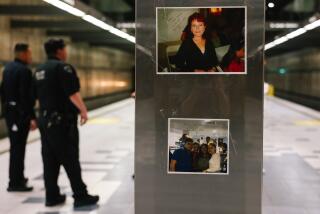A Subway Tumble Is Not as Likely as New Yorkers Fear
- Share via
NEW YORK — On the open platforms of the country’s largest subway system, where 7 million people crowd every day, almost every commuter is afraid of falling in front of a moving train.
It is an emotional tariff included in the $2 fare -- along with exposure to noise levels that exceed a jet engine at takeoff, platform air that contains 100 times the levels of metal dust found at street level, flashers, panhandlers and the occasional broken turnstile.
In the first public accounting of serious injuries in the New York subway system, doctors at the New York University School of Medicine identified 208 people killed or hurt badly enough to warrant emergency trauma treatment, such as amputation.
Overwhelmingly, the victims were most often tunnel people, not commuters, the researchers reported last week in the American Journal of Public Health.
Most of the injured were middle-age unemployed men, often suffering from mental illness, the researchers reported.
With so many of the mangled victims identified as homeless or unemployed, the researchers discovered that financial hard times in the surface world was the best predictor of accidents underground.
“The dips and peaks in the economy matched the numbers of injuries we were seeing,” said study author Dr. Amber Guth, an associate professor of surgery at NYU and a surgeon at Bellevue Hospital, which treats more subway injuries than any other hospital in the city.
“These were clearly the underprivileged.”
Even so, three-quarters of the century-old system’s daily riders are afraid of being pushed onto the tracks, according to the Archives of General Psychiatry. Many riders acknowledge taking specific precautions to avoid being shoved off a subway platform.
“I stand near the stairs where I could hold onto something if somebody started pushing me,” said Robyn Gershon, a public health expert at Columbia University who studies subway hazards.
To identify genuine public-safety hazards on the subways, however, reliable statistics are hard to come by.
The Metropolitan Transportation Authority, which moves 2.4 billion people a year in the largest transportation network in North America, does not normally make data about injuries public. A spokesman at the New York City Transit agency also could not provide any information on subway injuries.
For their survey, the NYU researchers could only tally injuries treated from 1990 to 2003 at Bellevue, which was recently designated the trauma treatment center for the transit system.
The youngest victim was 5, the oldest 93. About one in four had been injured in a suicide attempt. Twenty-eight people lost an arm or a leg. Twenty died in the hospital.
No one has systematically assessed the risk of being pushed onto the subway tracks since 1992, when researchers at NYU, UCLA and the Threat Assessment Group in Newport Beach identified 52 people from 1975 through 1991 killed or injured when someone shoved them onto the tracks as a train entered the station.
In the absence of hard data, riders rely on urban legend and anecdotal evidence -- the Internet broker jostled onto the rails in Union Square, the bystander at Columbia Circle knocked into the path of an arriving train by a fleeing murder suspect.
“There are always slips, trips, falls,” Gershon said. “Given the ridership rates, it actually is amazingly safe.”
More to Read
Sign up for Essential California
The most important California stories and recommendations in your inbox every morning.
You may occasionally receive promotional content from the Los Angeles Times.













